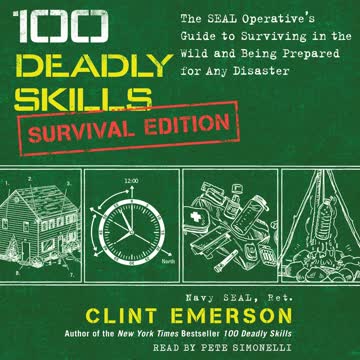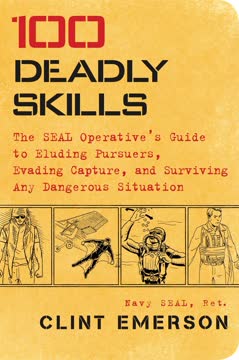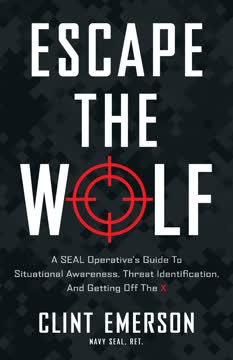Key Takeaways
1. Cultivate a Proactive Survival Mindset
The only elements of crisis under our control are our own preparation and response.
Embrace readiness. Most civilians live in a state of passive complacency, assuming daily routines will remain undisturbed. A survival mindset rejects this passivity, instead preparing for a range of undesirable possibilities, whether natural, man-made, urban, or rural. This proactive approach begins with a multi-pronged strategy for awareness and response.
Enhance awareness. Develop situational awareness by looking beyond your immediate "three-foot bubble," scanning your surroundings for potential threats, and identifying exits in crowded spaces. Combine this with personal and cultural awareness: avoid ostentatious displays that mark you as a target, and blend in with local customs when traveling. Women can reduce vulnerability by securing long hair and avoiding necklaces that offer a handle to predators.
Adopt an offensive stance. When a crisis threshold is crossed, switch from a defensive to an offensive mindset. In confrontations, match or exceed the aggressor's aggression. For natural disasters, aggressively move away from danger, controlling emotions and avoiding hysteria. This proactive spirit, combined with physical conditioning to push, pull, and lift your own body weight (and a loved one's), forms the bedrock of survivability.
2. Master Essential Navigation Without Technology
If you’ve performed a map study and outfitted yourself with a basic working knowledge of the environment, tracking the movements of our closest star—the sun—should help you find your way to safe ground.
Beyond GPS. Over-reliance on GPS is a liability; devices can fail, and signals can be lost under dense canopies or in inclement weather. Always carry a compass, extra batteries, and a map as backup. Crucially, perform a detailed map study before setting out, familiarizing yourself with landmarks within a 15-20 mile radius to make informed decisions if lost.
Nature's compass. Mother Nature provides abundant navigational clues.
- Environmental: Trees often have thicker foliage on eastern sides (western-prevailing winds), more branches on southern sides (more sunlight), and moss favoring northern, shaded sides.
- Solar: The sun rises in the east, casting shadows west in the morning and east in the afternoon. An analog watch can pinpoint south by aligning the hour hand with the sun; the halfway point to 12 o'clock indicates south.
- Celestial: In the Northern Hemisphere, the North Star (Polaris) remains fixed, found by aligning with the Big Dipper's outer stars or Cassiopeia. In the Southern Hemisphere, the Southern Cross points south. Orion's Belt indicates east-west at the equator.
Improvised tools. A DIY compass can be made by magnetizing a steel needle (e.g., by rubbing it on a battery) and floating it on water. This provides a general north-south axis, which can be refined using other natural navigation methods. Always combine improvised tools with a map for best results.
3. Adapt Survival Skills to Any Environment
A true warrior is prepared to fight in any environment on earth, protecting his or her loved ones from threats as varied as gunshot wounds and home intruders.
Environment dictates strategy. Survival is a game of adaptability, requiring specific skills tailored to diverse terrains. Each environment presents unique challenges for water, food, shelter, and movement, demanding a flexible approach to preparedness and execution.
Key environmental adaptations:
- Jungle: Use a Kukri knife for clearing paths. Protect skin from insects and plants with full coverage and pantyhose (leeches). Collect water from bamboo or vines. Build elevated bamboo hammocks to avoid ground predators.
- Arctic: Pack heavy gear on a sled to conserve energy. Wear multiple, breathable layers to prevent hypothermia. Melt ice for water (avoid eating snow). Build snow shelters (e.g., trench shelters) and fish through ice holes.
- Desert: Travel at night to conserve water. Build cooling shelters with tarps and dug-out sand. Identify edible plants like prickly pear cactus and chia sage. Conserve water by avoiding food if completely dehydrated.
- Wetland: Use dry bags to protect gear. Filter water with improvised charcoal systems. Build elevated swamp beds to escape cold, damp ground and water-borne creatures.
- Mountain: Use a mountain bike for transport. Purify water by boiling in a plastic bottle (last resort) or digging near shorelines. Set trotlines for fish. Build insulated shelters from branches and foliage.
Universal principles. Regardless of the environment, core survival needs remain: fire for warmth, cooking, and signaling; safe water for hydration; and shelter for protection from elements and predators. The ability to improvise tools from available materials is paramount.
4. Fortify Your Domain and Public Spaces
Effective home security consists in surrounding your home with active, concentric layers of security, starting with the outermost layer: the eyes and ears next door and across the street.
Home as a fortress. Home security extends beyond simple locks; it involves creating active, concentric layers of protection. Start with community: build rapport with neighbors, inform them of your travel, and control information shared on social media. Limit visibility into your home with covered windows and garage parking, while increasing your visibility of the perimeter with ample lighting and strategically placed cameras for ID-quality footage.
Tactical readiness. Transform your nightstand into a tactical toolbox, storing essential items within reach:
- Top: Cell phone (emergency calls), candle (power outage), steel-barreled pen (weapon).
- Drawer: Gun, fixed-blade knife, pepper spray, heavy-duty flashlight (weapon/search).
- Beside bed: Baseball bat, fire extinguisher, body armor.
An improvised concealable rifle rack can be made from two sturdy hangers under a mattress for quick access, though shotguns are often preferred for home defense due to less over-penetration.
Securing public spaces. In public buildings, barricading doors can buy precious time.
- Outward-opening doors: Jam with belts, purse straps, or rope around door-closer arms.
- Inward-opening doors: Fortify with multiple deadbolts, steel rods, or heavy furniture.
- Improvised bars: Combine brooms/mops with zip ties/duct tape to create a security bar.
Always move from cover to cover, seeking multiple escape routes, and remember there is strength in numbers.
5. Neutralize Immediate Public Threats
The last thing he’s expecting to encounter is a brave and violent act of resistance.
Personal safety vigilance. Public spaces harbor various threats, from petty crime to violent attacks.
- Pickpockets/Purse Snatchers: Travel light, avoid flashy items, be aware in crowded areas, use a comb in your wallet as a deterrent, and carry purses close to your body or across it (unless in an abduction risk area).
- Virtual Kidnappers: Prevent by limiting social media posts about travel or family. If contacted, stall, ask for proof of life, and try to contact the loved one directly.
- Express Kidnappers: In high-risk areas, keep car doors locked, use trusted taxis, and consider a dummy wallet with minimal cash and ID. If life is in danger, attempt escape.
- Abduction: Fight back aggressively, make noise, use improvised weapons (keys, pens, charger cords), and attempt escape during transit.
Countering armed threats. Detecting and neutralizing armed threats requires courage and decisive action.
- Concealed Handguns: Look for body language cues (palpating weapon, shifting weight), asymmetry in clothing, and negligence (accidental exposure).
- Suicide Bombers: Spot bulky clothing, extreme nervousness, or tunnel vision. If close, restrain hands immediately to prevent detonation. Shut down all mobile phones to create a Zero RF zone.
- Active Shooters/Hijackers: Do not act alone. Team up, gather improvised weapons (hot coffee, rolled newspapers, seat cushions), and plan a coordinated ambush. Use speed, surprise, and violent action to tackle, disarm, and restrain the assailant. For hijackers, consider jettisoning them from the plane as a last resort after depressurizing the cabin.
6. Prepare for and Survive Disasters
The world isn’t getting any safer. Be ready to stand your ground.
Proactive disaster planning. Disasters are unpredictable, ranging from natural phenomena to social unrest. Preparation is paramount, including a well-stocked go-bag (food, water, tools, signaling devices) and memorized evacuation routes.
Specific disaster responses:
- Tsunami: Heed nature's clues (earthquakes, receding shorelines, animal behavior). Immediately move to high ground (150 feet above sea level or two miles inland).
- Avalanche: Avoid high-risk slopes. If caught, move to flanks, grab solid fixtures, or "swim" with the snow. Create an air pocket in front of your face if buried.
- Earthquake: Identify safe zones (sturdy furniture, interior walls). Drop, cover, and hold on. Stay away from windows. If trapped, use a whistle or tap pipes to signal.
- Blizzard: Winterize home and vehicle. Avoid driving in low visibility. If stranded, stay in your car, run the engine for 10 minutes per hour, and use layers/insulation to prevent hypothermia.
- Tornado/Hurricane: Heed evacuation warnings. For tornadoes, go to the lowest, most central part of a solid building, away from windows. If outdoors, seek low ground (ditches). Do not attempt to outrun a tornado.
Navigating chaos. In social unrest or stampedes, avoid the center of crowds and move to the periphery or elevated ground. In a stampede, widen your stance, keep knees bent, protect your chest and head with your arms, and move with the flow, seeking gaps. If knocked down, assume the "tornado position" (fetal, hands behind neck) to protect vital areas and create breathing space.
7. Master Emergency Signaling for Rescue
When technology fails and options are limited, they may represent your only possible means of communicating with search and rescue teams or passersby.
Beyond technology. While smartphones are powerful tools, their battery life is finite. When tech fails, traditional distress signals become critical for communicating with rescuers.
Daytime signaling:
- Ground-based: Leave physical trails with text/symbols carved in sand/rock, or use bright duct tape/Sharpies. Create scent trails with clothing/urine for dogs.
- Air/Watercraft: Build large fires with pinecones, rubber, or plastic to create black smoke. Use reflective surfaces (ID card, can bottom, glass shard) to flash glare at passing aircraft. Carve oversized SOS signals in contrasting materials (leaves, rocks, snow).
Nighttime signaling:
- Person-to-person: Use a flashlight to strobe at cars or neighbors' windows, or create an SOS flicker.
- Vehicle: Use your car's panic button to flash hazards and headlights.
- Ground-to-air: Turn a flashlight into a "buzz saw" of light or "lasso" aircraft by sweeping the beam from the sky to your coordinates and back.
- Universal symbol: Arrange three light sources (ChemLights, flashlights, campfires) in a triangular pattern, the universal symbol for rescue.
Smartphone as a lifeline. To maximize smartphone utility: conserve battery (silent, low illumination, turn off Wi-Fi/Bluetooth), enable location services, and be clear/concise with 911. If calls fail, text 911 (if supported) or mass text loved ones, requesting confirmation texts. A dead phone can even be used as a last-resort fire starter. In captivity, leave a DNA trail (skin, hair, blood) and collect adversary's DNA to aid future investigations.
8. Administer Life-Saving First Aid
Any civilian who is witness to a catastrophic injury has the power to halt blood loss and stave off organ failure, using only his or her bare hands.
Triage in chaos. In mass casualty events, prioritize victims using triage protocol. First, determine consciousness (ambulatory first, then conscious but immobile, then unconscious). Focus on those who can't breathe or are bleeding profusely over those who are screaming (as screaming indicates breathing).
The ABCs of life support.
- Airway: Check for obstructions; perform a shallow finger sweep if needed.
- Breathing: Observe lung movement, listen for breath, and check for a pulse (neck, wrist, behind knee).
- Circulation/Bleeding: Immediately apply direct pressure to severe wounds, using your body weight to press arteries against bone. If direct pressure fails, apply intense force to vascular pressure points above the injury. As a last resort, use a shirt or belt as a tourniquet, tying it above the wound and seeking immediate medical attention.
Specific wound management:
- Gunshot Wounds: Apply direct pressure, use tampons/pads to clot bleeding, and check for exit wounds. Keep the victim calm and covered to prevent shock.
- Sucking Chest Wounds (Tension Pneumothorax): Seal the wound with flat, impermeable material (credit card, plastic wrap), taping on three sides to create a flutter valve that allows air out but not in.
- Foreign Object Impalements: Never remove the object. If in the chest, create an occlusive seal around it and brace the object to prevent movement.
- Suturing Cuts: For cuts over a quarter-inch, clean thoroughly. Use interrupted, continuous, or lock-stitch sutures with needle and thread. For scalp wounds, knot hair over the wound and super glue. Medical tape can butterfly small cuts.
- Minor Burns: Run cold water over first-degree burns. Avoid ice. Apply antibiotic ointment or home remedies like yellow mustard.
- Fractured Bones: Splint the bone to a rigid object (newspaper, sticks, poles) above and below the injury site to reduce pain and prevent further tissue damage. Tape the limb to the body for added immobilization.
A cricothyrotomy (creating an airway through the cricothyroid membrane) is a last-resort procedure for a mangled upper airway, only to be attempted by an untrained bystander with dispatcher guidance after all other less invasive methods have failed.
Last updated:
Review Summary
100 Deadly Skills receives mixed reviews, with an average rating of 4.03 out of 5. Many readers find it informative and practical, especially for survival scenarios and home security. Some praise its concise format and illustrations. Critics argue that much of the information is common knowledge or impractical for everyday life. Several reviewers recommend it as a reference book or toilet reading. The book's content ranges from basic survival skills to more specialized techniques. Some readers appreciate the author's expertise as a former Navy SEAL, while others find the content overwhelming or too extreme for average civilians.
Similar Books




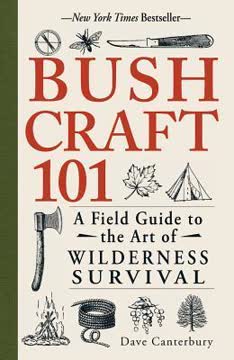
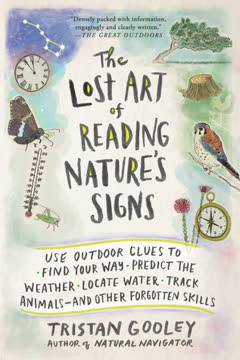




Download PDF
Download EPUB
.epub digital book format is ideal for reading ebooks on phones, tablets, and e-readers.
